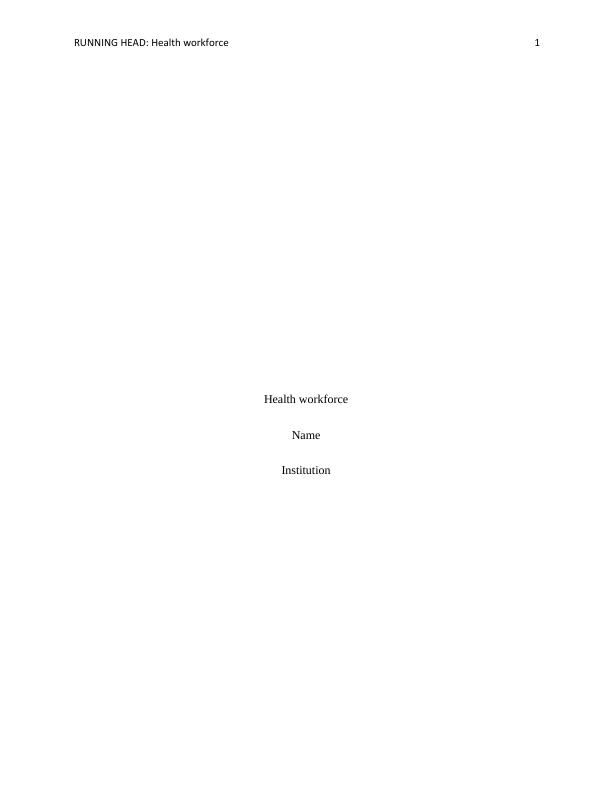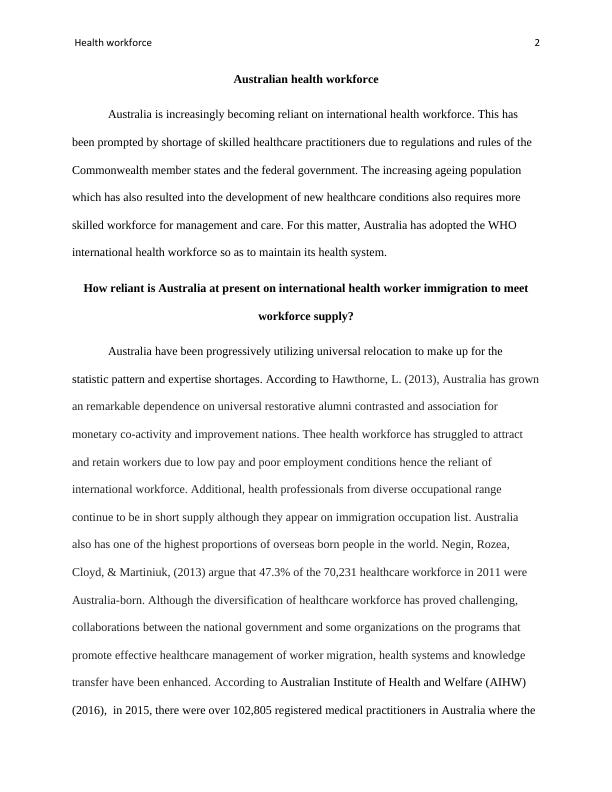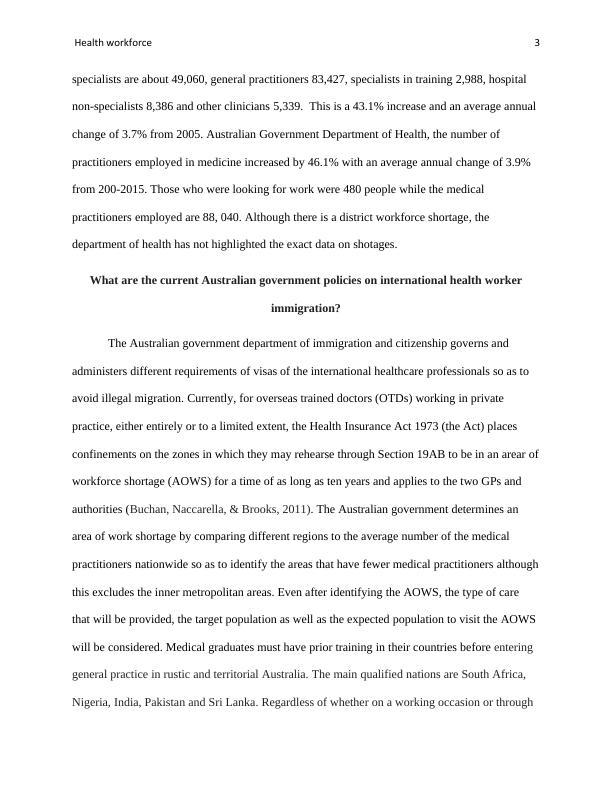Health Workforce in Australia: International Migration and Government Policies
Added on 2023-01-17
9 Pages2247 Words72 Views
RUNNING HEAD: Health workforce 1
Health workforce
Name
Institution
Health workforce
Name
Institution

Health workforce 2
Australian health workforce
Australia is increasingly becoming reliant on international health workforce. This has
been prompted by shortage of skilled healthcare practitioners due to regulations and rules of the
Commonwealth member states and the federal government. The increasing ageing population
which has also resulted into the development of new healthcare conditions also requires more
skilled workforce for management and care. For this matter, Australia has adopted the WHO
international health workforce so as to maintain its health system.
How reliant is Australia at present on international health worker immigration to meet
workforce supply?
Australia have been progressively utilizing universal relocation to make up for the
statistic pattern and expertise shortages. According to Hawthorne, L. (2013), Australia has grown
an remarkable dependence on universal restorative alumni contrasted and association for
monetary co-activity and improvement nations. Thee health workforce has struggled to attract
and retain workers due to low pay and poor employment conditions hence the reliant of
international workforce. Additional, health professionals from diverse occupational range
continue to be in short supply although they appear on immigration occupation list. Australia
also has one of the highest proportions of overseas born people in the world. Negin, Rozea,
Cloyd, & Martiniuk, (2013) argue that 47.3% of the 70,231 healthcare workforce in 2011 were
Australia-born. Although the diversification of healthcare workforce has proved challenging,
collaborations between the national government and some organizations on the programs that
promote effective healthcare management of worker migration, health systems and knowledge
transfer have been enhanced. According to Australian Institute of Health and Welfare (AIHW)
(2016), in 2015, there were over 102,805 registered medical practitioners in Australia where the
Australian health workforce
Australia is increasingly becoming reliant on international health workforce. This has
been prompted by shortage of skilled healthcare practitioners due to regulations and rules of the
Commonwealth member states and the federal government. The increasing ageing population
which has also resulted into the development of new healthcare conditions also requires more
skilled workforce for management and care. For this matter, Australia has adopted the WHO
international health workforce so as to maintain its health system.
How reliant is Australia at present on international health worker immigration to meet
workforce supply?
Australia have been progressively utilizing universal relocation to make up for the
statistic pattern and expertise shortages. According to Hawthorne, L. (2013), Australia has grown
an remarkable dependence on universal restorative alumni contrasted and association for
monetary co-activity and improvement nations. Thee health workforce has struggled to attract
and retain workers due to low pay and poor employment conditions hence the reliant of
international workforce. Additional, health professionals from diverse occupational range
continue to be in short supply although they appear on immigration occupation list. Australia
also has one of the highest proportions of overseas born people in the world. Negin, Rozea,
Cloyd, & Martiniuk, (2013) argue that 47.3% of the 70,231 healthcare workforce in 2011 were
Australia-born. Although the diversification of healthcare workforce has proved challenging,
collaborations between the national government and some organizations on the programs that
promote effective healthcare management of worker migration, health systems and knowledge
transfer have been enhanced. According to Australian Institute of Health and Welfare (AIHW)
(2016), in 2015, there were over 102,805 registered medical practitioners in Australia where the

Health workforce 3
specialists are about 49,060, general practitioners 83,427, specialists in training 2,988, hospital
non-specialists 8,386 and other clinicians 5,339. This is a 43.1% increase and an average annual
change of 3.7% from 2005. Australian Government Department of Health, the number of
practitioners employed in medicine increased by 46.1% with an average annual change of 3.9%
from 200-2015. Those who were looking for work were 480 people while the medical
practitioners employed are 88, 040. Although there is a district workforce shortage, the
department of health has not highlighted the exact data on shotages.
What are the current Australian government policies on international health worker
immigration?
The Australian government department of immigration and citizenship governs and
administers different requirements of visas of the international healthcare professionals so as to
avoid illegal migration. Currently, for overseas trained doctors (OTDs) working in private
practice, either entirely or to a limited extent, the Health Insurance Act 1973 (the Act) places
confinements on the zones in which they may rehearse through Section 19AB to be in an arear of
workforce shortage (AOWS) for a time of as long as ten years and applies to the two GPs and
authorities (Buchan, Naccarella, & Brooks, 2011). The Australian government determines an
area of work shortage by comparing different regions to the average number of the medical
practitioners nationwide so as to identify the areas that have fewer medical practitioners although
this excludes the inner metropolitan areas. Even after identifying the AOWS, the type of care
that will be provided, the target population as well as the expected population to visit the AOWS
will be considered. Medical graduates must have prior training in their countries before entering
general practice in rustic and territorial Australia. The main qualified nations are South Africa,
Nigeria, India, Pakistan and Sri Lanka. Regardless of whether on a working occasion or through
specialists are about 49,060, general practitioners 83,427, specialists in training 2,988, hospital
non-specialists 8,386 and other clinicians 5,339. This is a 43.1% increase and an average annual
change of 3.7% from 2005. Australian Government Department of Health, the number of
practitioners employed in medicine increased by 46.1% with an average annual change of 3.9%
from 200-2015. Those who were looking for work were 480 people while the medical
practitioners employed are 88, 040. Although there is a district workforce shortage, the
department of health has not highlighted the exact data on shotages.
What are the current Australian government policies on international health worker
immigration?
The Australian government department of immigration and citizenship governs and
administers different requirements of visas of the international healthcare professionals so as to
avoid illegal migration. Currently, for overseas trained doctors (OTDs) working in private
practice, either entirely or to a limited extent, the Health Insurance Act 1973 (the Act) places
confinements on the zones in which they may rehearse through Section 19AB to be in an arear of
workforce shortage (AOWS) for a time of as long as ten years and applies to the two GPs and
authorities (Buchan, Naccarella, & Brooks, 2011). The Australian government determines an
area of work shortage by comparing different regions to the average number of the medical
practitioners nationwide so as to identify the areas that have fewer medical practitioners although
this excludes the inner metropolitan areas. Even after identifying the AOWS, the type of care
that will be provided, the target population as well as the expected population to visit the AOWS
will be considered. Medical graduates must have prior training in their countries before entering
general practice in rustic and territorial Australia. The main qualified nations are South Africa,
Nigeria, India, Pakistan and Sri Lanka. Regardless of whether on a working occasion or through

End of preview
Want to access all the pages? Upload your documents or become a member.
Related Documents
Health Workforce Planninglg...
|12
|2537
|341
Health Workforce Planninglg...
|13
|2142
|199
Health Workforce Planninglg...
|12
|2430
|21
Australia's Reliance on International Health Worker Immigrationlg...
|11
|2202
|27
Health Workforce Planninglg...
|13
|2674
|52
Reliance of Australia on Foreign Born Healthcare Service Providerslg...
|13
|2412
|30
